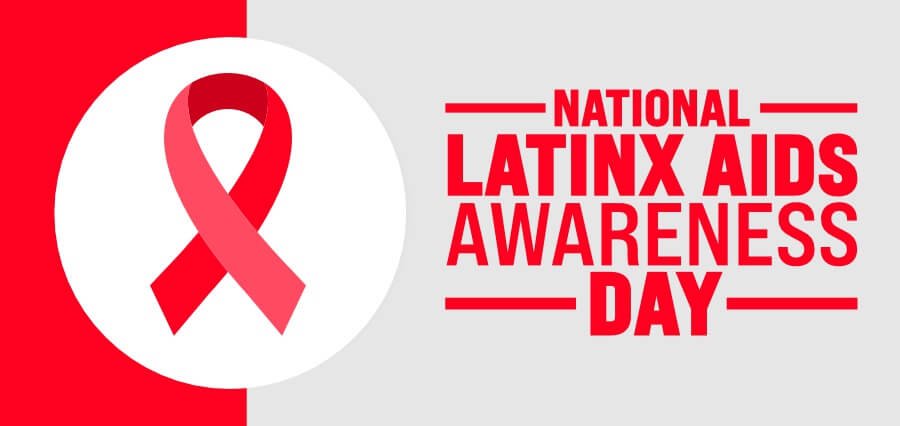The most severe HIV infection is termed AIDS. AIDS stands for Acquired Immunodeficiency Syndrome. A patient with AIDS can face more severe illnesses since their body immune systems have been compromised. A patient is diagnosed with AIDS when their CD4 cell count falls to under 200 cells per cubic millimeter of blood or when they develop certain symptoms.
Let’s Explore about National Latinx AIDS Awareness Day
The prevention and treatment of HIV can be done using Antiretroviral Therapy as known as ART. The virus stays dormant in the body’s cells, but ART can prevent blood levels from being detected. AIDS patients usually live for three years without treatment. Within a year of beginning treatment, individuals with a high CD4 count and an undetectable viral load can anticipate living roughly the same amount of time as those without HIV. The transmission of HIV generally happens through vaginal secretions, semen, breast milk and blood. Kisses, embraces, and meal sharing do not spread it. In the US and its territories, October 15th is designated as National Latinx AIDS Awareness Day (NLAAD).
NLAAD aims to minimise the effect of HIV in Latinx Hispanic people, spread awareness of HIV, and promotes HIV testing. Since its inception in 2003 by the Latino Commission on AIDS and the Hispanic Federation, the Latino Commission on AIDS and the Hispanic Federation have formally observed NLAAD.
CDC is dedicated to increasing HIV prevention practices among Hispanic/Latino populations, PrEP and HIV testing, culturally responsive programs and linkage to care and treatment from diagnosis. The purpose of National Latinx AIDS Awareness Day (NLAAD) is to lessen HIV stigma among Hispanic/Latino individuals in the US and to encourage community mobilization, HIV testing, prevention, and treatment. The Hispanic Federation and the Latino Commission on Latinx AIDS co-founded NLAAD almost 20 years ago.
While only 18% of the US population is Hispanic/Latino, these individuals accounted for 33% of HIV incidence overall in 2022, with 39% of HIV incidence occurring in Hispanic/Latino homosexual and bisexual men. Social and structural determinants continue to shape access to healthcare and prevention programs fueled by racism, xenophobia, transphobia, homophobia, poverty, and stigma despite the fact that rates of HIV incidence have remained steady among Hispanic/Latinos. The spread of Latinx AIDS was observed.
CDC is dedicated to increasing HIV prevention practices in Hispanic/Latino populations, such as PrEP (pre-exposure prophylaxis) and HIV testing, culturally relevant programs, and prompt access to care and treatment following diagnosis. Its dedication towards Latinx AIDS awareness is exemplified by initiatives like Project Confianza, which focuses on gay and bisexual males and attempts to identify and solve the factors that contribute to medical mistrust among the Hispanic and Latino populations in the United States.
The teams are thrilled about PrEPared/PrEParado, a recently created program under the Let’s Stop HIV Together campaign that attempts to address inequities in PrEP use among men who have sex with males in the South, including homosexual, bisexual, same-gender loving men.
Our priorities and actions are centered on community about Latinx AIDS. We acknowledge the significant work that our Hispanic/Latino community partners do in the areas of health education, HIV prevention, advocacy, capacity building, and behavioural health research, and we are honored to join them in this endeavour.
In a number of forums, such as the US Conference on HIV/AIDS (USCHA), the Hispanic Health Summit, and the National LatinX Conference, CDC leadership has been meeting with community members to talk about how we can effectively build bridges with and for Hispanic/Latino communities, how we can address the HIV workforce to attract the next generation of Hispanic/Latino leaders, and the ongoing need for bi-directional community engagement.
The need for sustained collaboration and dedication to halting the HIV epidemic is frequently emphasized. Efforts are made to improve Latinx AIDS awareness, prevention, HIV testing, and treatment in Latino Hispanic population.
15th October is observed as National Latinx AIDS Awareness Day(NLAAD). In the year 2003, NLAAD was first organized by the Latino Commission on AIDS (LCOA) and the Hispanic Federation. NLAAD offers an opportunity to address the disproportionate burden of HIV in Hispanic/Latinx communities, promote HIV testing, and fight HIV stigma. The widespread distribution of Latinx AIDS has been in concern. Additionally, it is a community mobilization intervention that fosters effective approaches to preventing, treating, and stopping the spread of HIV among Hispanics/Latinx peoples.
In the theme “Start Treatment, the NLAAD 2024 campaign unites communities, service providers, and organizations that offer services to Hispanics and Latinx people across the United States and territories. Keep at it and improve. Although the entire community is the target of this year’s campaign, individuals living with HIV are the main focus. In order to preserve their health, achieve an undetectable viral load, and halt the transmission of HIV, the campaign encourages people to select one of the numerous available treatment alternatives for Latinx AIDS (treatment as prevention).
The LCOA is holding a series of NLAAD webinars this year. Everyone is welcome to attend the webinars. The NLAAD website has the recordings of the webinars, and question and answer session on Latinx AIDS is also arranged. Spanish interpretation will be available for all webinars. Check out the list of webinars below and sign up right away to participate in these crucial discussions.
The Latino AIDS Commission
The non-profit LCOA is at the forefront of HIV education, community organization capacity building, model prevention initiatives for high-risk groups, and Latino health advocacy. In order to meet health challenges and address the impact of HIV and AIDS, hepatitis, and sexually transmitted infections in communities across the nation, the organization works to mobilize an effective community response through a wide network of Hispanic and Latinx community leaders and partner organizations.
Read More – Click Here





